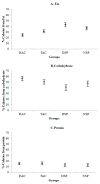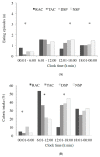Eating Behavior (Duration, Content, and Timing) Among Workers Living under Different Levels of Urbanization
- PMID: 32023914
- PMCID: PMC7071231
- DOI: 10.3390/nu12020375
Eating Behavior (Duration, Content, and Timing) Among Workers Living under Different Levels of Urbanization
Abstract
Urbanization has contributed to extended wakefulness, which may in turn be associated with eating over a longer period. Here, we present a field study conducted in four groups with different work hours and places of living in order to investigate eating behavior (duration, content, and timing). Anthropometric measures were taken from the participants (rural (n = 22); town (n = 19); city-day workers (n = 11); city-night workers (n = 14)). In addition, a sociodemographic questionnaire was self-answered and 24-h food recalls were applied for three days. The 24-h food recalls revealed that fat intake varied according to the groups, with the highest consumption by the city-day workers. By contrast, city-day workers had the lowest intake of carbohydrate, whereas the rural group had the highest. In general, all groups had some degree of inadequacy in food consumption. Eating duration was negatively correlated with total energy intake, fat, and protein consumption in the rural and town groups. There was a positive correlation between body mass index and eating duration in both city groups. The rural group had the earliest start time of eating, and this was associated with a lower body mass index. This study suggested that food content and timing, as well as eating duration, differed according to place of living, which in turn may be linked to lifestyle.
Keywords: eating duration; food content; meal timing; urbanization.
Conflict of interest statement
The authors declare that they have no competing interests.
Figures





Similar articles
-
Living in Rural and Urban Areas of New Caledonia: Impact on Food Consumption, Sleep Duration and Anthropometric Parameters Among Melanesian Adolescents.Nutrients. 2020 Jul 10;12(7):2047. doi: 10.3390/nu12072047. Nutrients. 2020. PMID: 32664246 Free PMC article.
-
Weekday-Weekend Differences in Chrononutritional Variables Depend on Urban or Rural Living.Nutrients. 2024 Dec 30;17(1):108. doi: 10.3390/nu17010108. Nutrients. 2024. PMID: 39796541 Free PMC article.
-
Urban rural differences in diet, physical activity and obesity in India: are we witnessing the great Indian equalisation? Results from a cross-sectional STEPS survey.BMC Public Health. 2016 Aug 18;16(1):816. doi: 10.1186/s12889-016-3489-8. BMC Public Health. 2016. PMID: 27538686 Free PMC article.
-
[Simple obesity in children. A study on the role of nutritional factors].Med Wieku Rozwoj. 2006 Jan-Mar;10(1):3-191. Med Wieku Rozwoj. 2006. PMID: 16733288 Review. Polish.
-
Relationship between different levels of the Mexican food environment and dietary intake: a qualitative systematic review.Public Health Nutr. 2020 Aug;23(11):1877-1888. doi: 10.1017/S1368980019004294. Epub 2020 Mar 27. Public Health Nutr. 2020. PMID: 32216850 Free PMC article.
Cited by
-
Content Validation of a Chrononutrition Questionnaire for the General and Shift Work Populations: A Delphi Study.Nutrients. 2021 Nov 15;13(11):4087. doi: 10.3390/nu13114087. Nutrients. 2021. PMID: 34836341 Free PMC article.
-
From Ampesie to French fries: systematising the characteristics, drivers and impacts of diet change in rapidly urbanising Accra.Sustain Sci. 2022 Aug 16:1-25. doi: 10.1007/s11625-022-01195-y. Online ahead of print. Sustain Sci. 2022. PMID: 35990025 Free PMC article.
-
Development and Evaluation of Integrated Chrono-Nutrition Weight Reduction Program among Overweight/Obese with Morning and Evening Chronotypes.Int J Environ Res Public Health. 2022 Apr 7;19(8):4469. doi: 10.3390/ijerph19084469. Int J Environ Res Public Health. 2022. PMID: 35457337 Free PMC article.
-
Associations between temporal eating patterns and body composition in young adults: a cross-sectional study.Eur J Nutr. 2024 Sep;63(6):2071-2080. doi: 10.1007/s00394-024-03414-x. Epub 2024 May 3. Eur J Nutr. 2024. PMID: 38700577
References
-
- Beale A.D., Pedrazzoli M., Gonçalves B.S.B., Beijamini F., Duarte N.E., Egan K.J., Knutson K.L., von Schantz M., Roden L.C. Comparison between an African town and a neighbouring village shows delayed, but not decreased, sleep during the early stages of urbanisation. Sci. Rep. 2017;7:5697. doi: 10.1038/s41598-017-05712-3. - DOI - PMC - PubMed
-
- De La Iglesia H.O., Fernández-Duque E., Golombek D.A., Lanza N., Duffy J.F., Czeisler C.A., Valeggia C.R. Access to electric light is associated with shorter sleep duration in a traditionally hunter-gatherer community. J. Biol. Rhythms. 2015;30:342–350. doi: 10.1177/0748730415590702. - DOI - PMC - PubMed
MeSH terms
Grants and funding
LinkOut - more resources
Full Text Sources
Medical

